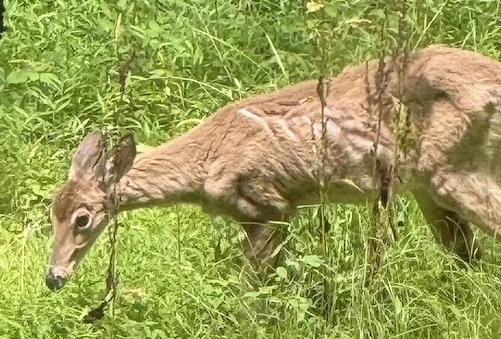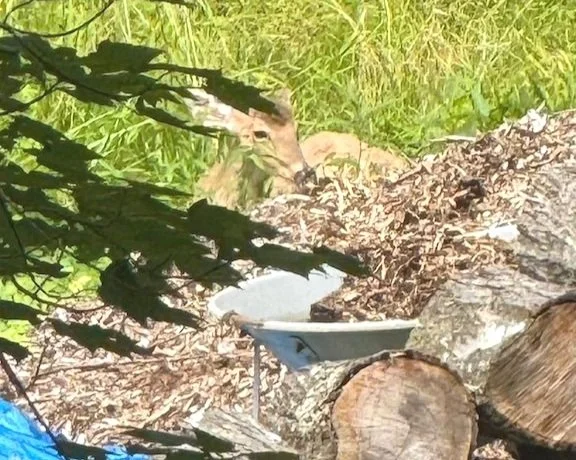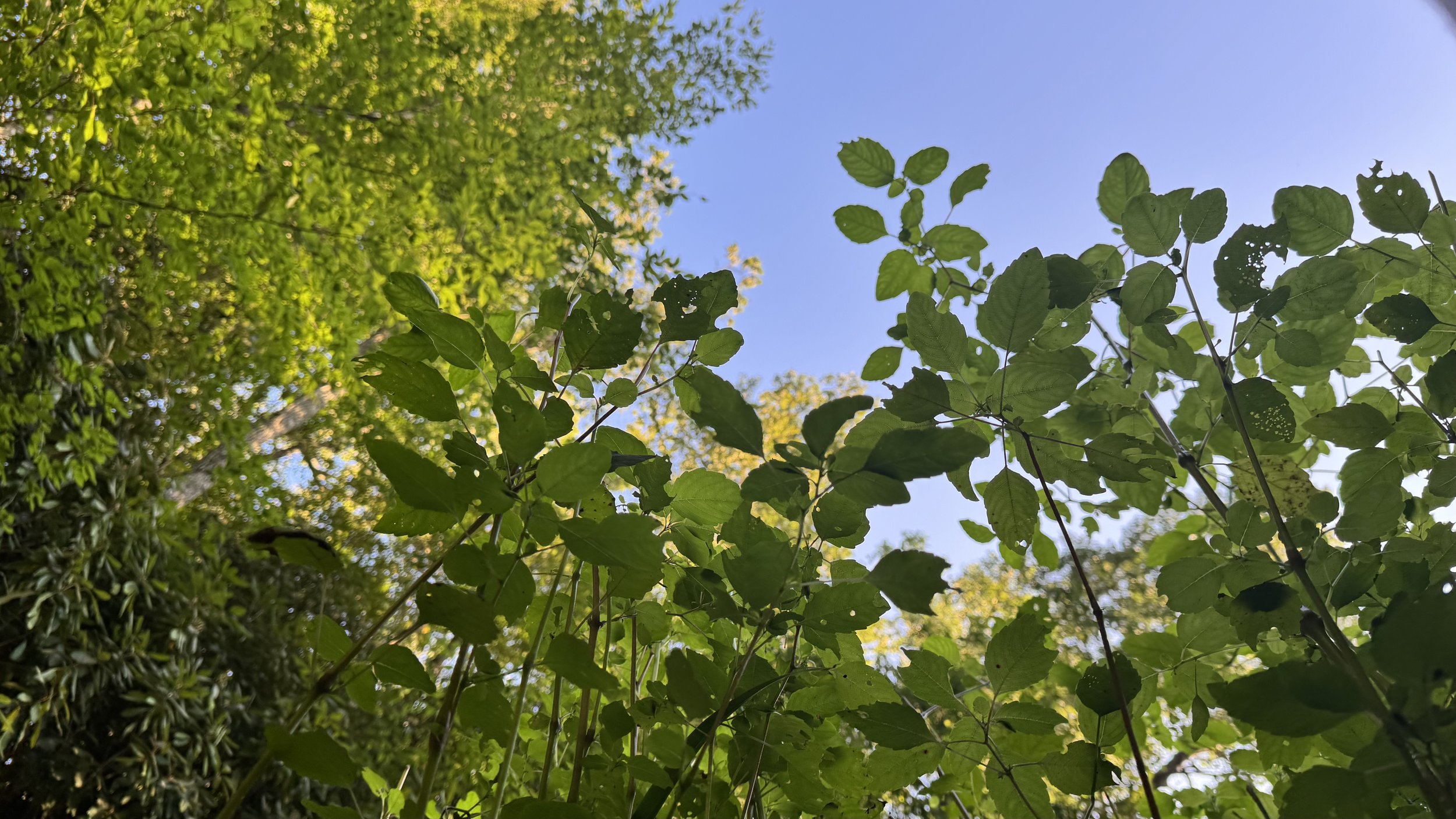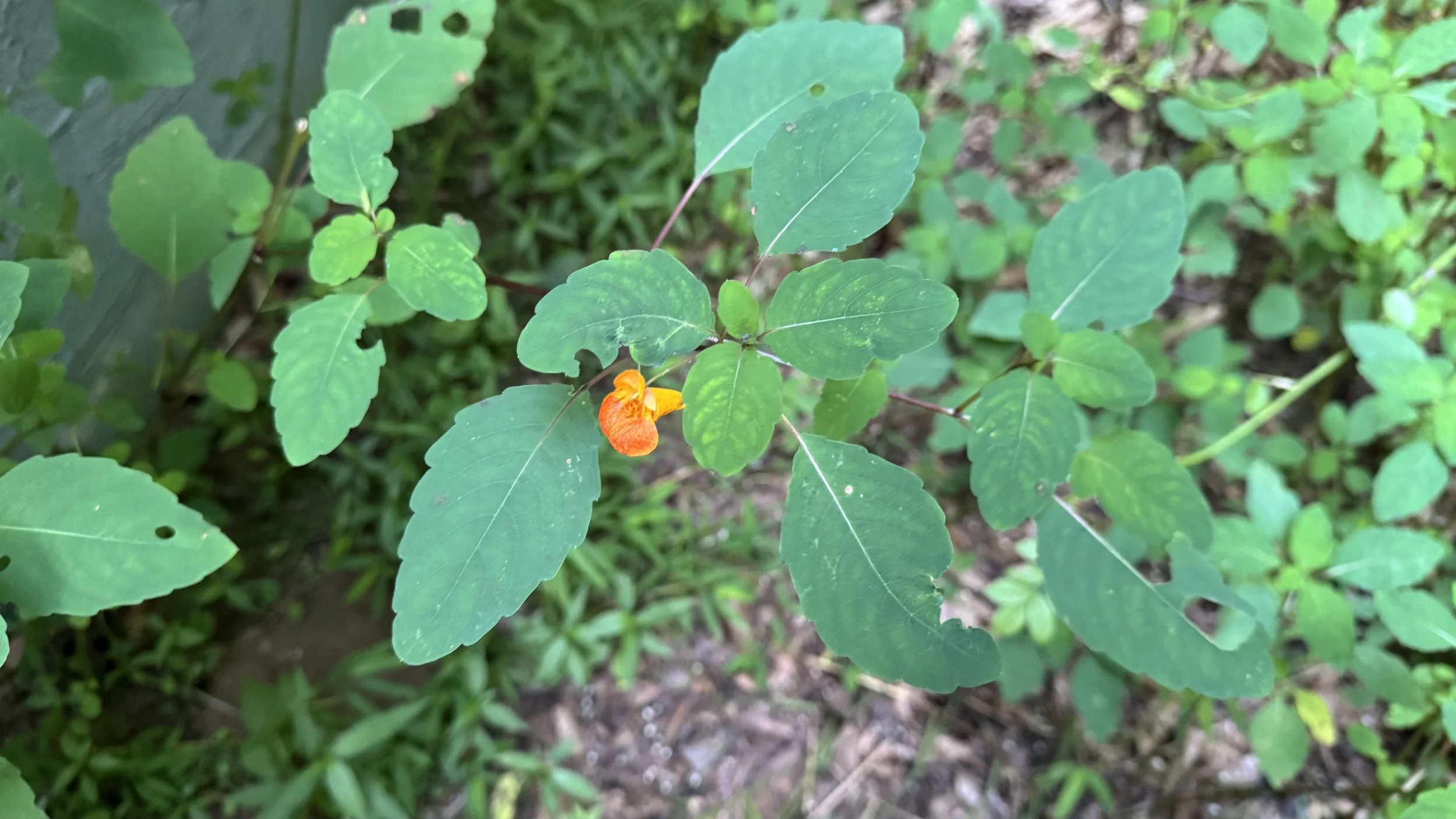Antlers in the Dark: What Two Deer Taught Me About Fragility and Strength
The sick deer stands unmoving in the yard, its glassy eyes meeting mine through the kitchen window.
I was in my kitchen when I saw the deer for the first time. Just before 8 p.m., the light slipping toward night.
I noticed its ribs, hips, and patchy coat before it noticed me. When it did, it just stared, beady, almost soulless eyes locking on mine through the glass. My gut told me something was wrong, but I tried to convince myself maybe it was just different. Genetically. Like so many of us.
The same deer slowly roams the yard at dusk, pausing to nibble the edges of plants as if searching for comfort.
I stayed at the window longer than I meant to, studying the way it carried its body, how the sharp angles of its hips and ribs jutted out against its patchy coat. The deer would look up occasionally, its gaze scanning the air before it lowered its head again. It didn’t seem afraid of me, and that unsettled me more than if it had bolted.
Eventually I went back to my day, though I couldn’t stop thinking about it. I picked up my phone and began looking up numbers for wildlife services and animal control, planning to call the next day.
I wondered if it would come back or if this was just a passing encounter. There was so little I could do standing at the window, and that left me restless, unsure of how much to worry or whether I was overreacting.
Searching for Help: A Race Against Time
A daytime shot of the deer looking noticeably thinner with ragged fur, standing in tall green grass.
I saw it again on July 12, almost three weeks later. It looked thinner now, its coat more ragged. But it didn’t limp or stagger. It still moved with a strange steadiness, which somehow made it harder to tell how sick it was.
I felt a heaviness settle in. Sadness. Concern. I couldn’t stop thinking about it. I started calling for help again, but it was the weekend and fish and wildlife were closed. The only service I could reach was animal control, who said they might be able to get back to me in a week.
I thought about trying to put it down myself, but the deer was nowhere to be found. It was like a game of hide-and-seek: one moment here, then disappearing into the woods.
The deer curled up resting partially hidden by a pile of mulch.
I spent hours researching what to do, learning that I shouldn’t feed it or get close, and that testing for Chronic Wasting Disease (CWD) was crucial. CWD is a fatal prion disease that affects deer, elk, and moose, and there had already been thirteen cases confirmed in the state this year. If a sick deer isn’t tested, the disease can quietly spread through herds and even contaminate the soil and plants where it dies.
I knew that timing mattered. I kept calling and searching, but the deer never stayed in one place long enough to act.
A vulture, the ancient symbol of death and renewal, waits with patient stillness.
The Vulture Appears: A Sign in the Sky
At one point, a vulture appeared in the sky, circling. My stomach dropped. I wondered if it had already died, or if the vulture simply sensed what I could not yet see. The vulture landed for a while on the pitch of the roof of my garage, patient and still, as if waiting. Watching it felt unsettling, but also honest.
Vultures are the ultimate symbol of death being near. They do what they are here to do: turn death back into life.
A bouquet of St. John’s Wort, a plant that once symbolized stability in the garden before the floods came.
The Last Time I Saw It: A Final Encounter
The following weekend, it came back one last time. I startled it by the garage without meaning to as it lay curled next to the old truck camper shell, half-hidden by the overgrown jewelweed. For a moment, we both froze, the deer blinking up at me through the tangle of stems.
The plants had exploded after Helene’s flooding, swallowing the edges of the garage and creeping across paths I once kept clear. They had replaced the St. John’s Wort that grew here when we first moved in, a plant that had felt like a small symbol of stability. The jewelweed was wilder, unruly, spilling into every corner, a reflection of my own sense of overwhelm trying to keep up with the land’s constant changes.
The jewelweed grew thick and wild, concealing the quiet path where the deer had spent its final days.
The deer’s body lay motionless, its stillness both heartbreaking and inevitable.
The deer scrambled to its feet in a rush, startled by my presence. For a moment it froze, eyes wide, as if trying to decide whether to trust me or run. Then instinct took over. It stumbled as it fled, its legs moving with a flash of strength but out of sync, a heartbreaking rhythm of survival colliding with neurological decline. I could hear the frantic crash of its body through the jewelweed and brambles, the plants snapping and rustling louder than I had ever heard. Then, silence.
We searched for it, weaving slowly through the woods, calling softly even though I knew it wouldn’t answer. The forest felt impossibly large, the jewelweed rising like walls around us. Every broken twig or movement of wind felt like a clue, but the woods swallowed the deer completely.
Not long after, we found it dead. The stillness of its body was startling after the chaos of the chase, the absence of breath and movement settling heavily in the air. I stood there for a long moment, feeling the weight of the inevitable finally landing.
The healthy and alert deer had been nearby as the sick one neared its final days.
The Resting Place: Finding the Body
Just before we found the body, we heard a deer huffing and crashing away through the trees. For a moment I thought it might be the sick deer, but I doubted it because of how unsteady it had been the last time I saw it.
Later I realized it was the healthy deer I had seen during this time, strong and defensive, huffing and puffing before bolting into the woods. Now I understood it had been staying close, keeping watch over the one who was dying.
By this point, I had finally gotten through to someone at the state wildlife office. They reminded me that technically it was the landowner’s responsibility, but I explained that CWD testing was key to protecting the other herds. They agreed to escalate the case and passed my information to a biologist, who called within hours.
I knew the risks of handling it myself. If a deer infected with CWD is buried shallowly, the prions that cause the disease can linger in the soil and plants for years. And while there’s no confirmed transfer to humans, studies haven’t fully ruled it out. With my own health issues, I wasn’t about to take that chance. Moments like these highlight the role of disgust. It’s a primal protective mechanism, a boundary that has kept beings safe in the wild for millennia and still has its place in the modern world.
If it had died from a car accident, I probably would have buried it or taken it to the landfill (which I also called about that day). But with a neurological illness in the picture, I waited for the biologist, who collected the body so it could be properly tested.
The last trace: a patch of flattened grass and tufts of hair where the deer had died.
After the body was gone, the place where it had lain was still pressed into the earth. A small trail led through the jewelweed, the plants parted just enough for a deer-sized passage. It felt like a quiet marker, a space the deer had chosen in its final moments.
The healthy deer I had seen so many times before returned later that day and lingered near the spot, as if keeping vigil. I realized then it was the same deer, now the sole witness to its companion’s final days.
I kept imagining what it saw from that resting place: the canopy above, the orange glow of jewelweed flowers at its eye level, the stillness.
The point of view from the deer’s final resting place.
Fragility and Resilience: What the Deer Taught Me
My mind went back and forth between logic and grief until I finally landed in acceptance. I honored the deer in my own quiet way, grateful that it had chosen my land as a place to return to. Maybe even to die.
Not long after, I was in the city when I saw another deer. We didn’t see the impact, only the aftermath.
Traffic had stopped in both directions. The deer was thrashing in the road, trying to get up but unable to. The driver stood nearby, frozen, in shock. Everyone seemed unsure of what to do. Time felt like it stopped.
I felt it in my gut and chest, a tightening, a helpless ache. There was a restless urgency to do something, anything, but instead I collapsed into tears. We drove past. I turned around as the passenger, looking back one last time. That’s when I saw the deer lower its head, and then the road curved away, and it was gone from sight.
Both deer taught me about suffering and helplessness. About how cruel nature and life can feel. They reminded me how fragile and vulnerable everything is. How quickly it can all slip away.
Maybe that’s the meaning, or at least part of it. The cycles I can’t control. The death of old patterns. The death of the selves we once were.
The deer on my property felt like a mirror when it was alive, and when it was gone, its eyes turned to glass. I keep thinking about what it would mean to be like the deer, gentle with myself when I’m sick or weak. And maybe also strong in ways I don’t yet fully understand.
I keep thinking about the deer’s eyes, how they felt like a mirror when it was alive and like glass when it was gone. It reminded me that life is both impossibly fragile and impossibly resilient.
In many traditions, deer are seen as guides through thresholds. This one felt like that for me, a quiet teacher. Its illness, the jewelweed rising after the flood, even the shift in my own body, all part of the same cycle.
I don’t know what the next season will bring, but I know we are all walking these cycles. Something dying. Something growing. Both at once.
Your turn
What’s been teaching you about fragility and strength lately?
Have you ever witnessed something that changed the way you see life’s cycles?
Leave a comment or write it down somewhere. Let yourself reflect. We all need those reminders sometimes.
A partially decomposed deer skull with antlers, nature’s reminder of what remains and what is reclaimed.
















